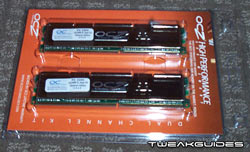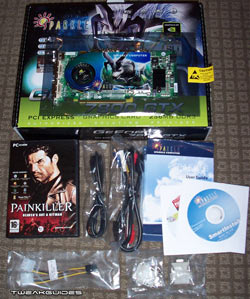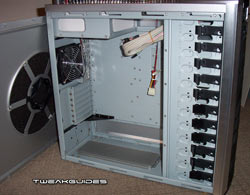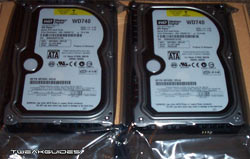Hardware Confusion
[Page 5] The Decisions I Made and Why (Pt.2)
RAM
My choice: 2 x 1GB OCZ PC-3200 Platinum EL (2-3-2-5)
RAM is always tricky to choose, because most people only pay attention to the amount of RAM (i.e. 512MB, 1GB, etc.), and perhaps its maximum speed (e.g. DDR PC3200) and never the configuration it comes in (i.e. how many sticks), and the latencies it does by default. To most people, 1GB of RAM sounds like plenty and very future-proof too. However times are changing and already we are seeing games which will run with frequent loading pauses due to insufficient RAM - namely Battlefield 2. So I would suggest 1GB is the minimum anyone with a new system should look at, with 2GB more useful now and into the future.
Note that AMD systems don't currently support the new DDR2 RAM, and still use the more common DDR RAM. In practical terms this is not a major issue, particularly as there's not much that can be done about it if you choose to go AMD.
Then there is the configuration. As it turns out, I was quickly told by AMD enthusiasts that any 4 x 512MB sticks on my DFI NF4 SLI-DR motherboard will only do 2T Command Rate as opposed to 1T which is optimal. The importance of Command Rate is discussed here for example, and in practical terms it's only a few % difference, but why lose a few % performance for around the same price? Therefore I chose 2x1GB sticks which not only give me the fastest memory timings (aka RAM Latency) at this configuration (i.e. 2-3-2-5), as well as 1T Command Rate, they also leave me with 2 free RAM slots in case I want to upgrade to 4GB in a year or so. The RAM also comes with heat spreaders which are a nice touch in keeping them more stable and allowing more headroom if I want to overclock them down the track. Finally, there have been many testimonials by various DFI NF4 SLI-DR users that certain RAM modules have problems on these motherboards. I once again turned to the experts on this motherboard who told me to purchase the OCZ RAM as it is fast and stable on this motherboard - something I wouldn't have known if I hadn't researched and consulted with the pros. I saved myself a lot of heartache simply by doing my homework before buying.
Graphics
My choice: Sparkle 7800GTX 256MB PCI-E
When I ordered my new system, I originally had a 256MB Nvidia 6800GT PCI-E card on the list. Then news broke that the 256MB 7800GTX PCI-E was arriving, and on average performed the same if not better than even 2 x 6800 Ultra graphics cards in SLI mode. I quickly began reading all available reviews and found that this seemed to be the case, and that the card had the best hardware support for Shader Model 3.0 and HDR. My previous ATI 9800 Pro had been excellent and certainly I am neither an ATI or an Nvidia fanboy (I've written both the Nvidia Forceware Tweak Guide and the ATI Catalyst Tweak Guide) - both brands are quite good at what they do. However looking at current and upcoming graphics card offerings, the rumored ATI next-generation card (codenamed R520/R580) has not yet appeared, and likely may not do so for another few months. The current ATI cards lack SM3.0 and HDR hardware support, which is a key feature in current games like Splinter Cell: Chaos Theory, Far Cry, Half Life 2 (Lost Coast HDR levels), and more and more upcoming games.
A couple of things really clinched the deal: Nvidia's SLI technology - which my motherboard is equipped with - means that I can purchase one 7800GTX now and in the future add another Nvidia graphics card and see almost double the performance in certain games; the second was that amazingly the price of the 7800GTX was lower than the older, slower 6800 Ultra, and much lower than the usual 'latest-and-greatest' offerings. Here in Australia, that means around $850AUD rather than the usual $1000+AUD. I switched to a 7800GTX at the last minute, and if you read on in this article you'll see my thoughts on how it's turned out.
By the way, I chose the Sparkle brand as it was one of the cheapest. I usually don't buy cheap brands, but given that the 7800GTXs all come on the Nvidia Reference Design boards, and are virtually identical except for the software bundles and slight clock speed differences, I saved almost $200AUD just by going with Sparkle. And the reviews of the Sparkle card (among some of the first to come out) did not show any negatives. Finally, this card has the same warranty as all other GTX's, confirming that it is essentially the same basic board as other brands.
Of course ATI also have an equivalent dual graphics card technology called Crossfire, which looks very promising indeed. It will provide performance improvements across the board in all games, because it uses a different method to utilizing both cards than SLI does. However once again I went for something which is available right now, and is relatively tried and tested, and receiving significant driver support - say what you will about SLI or Nvidia, their drivers have always been fantastic, and there are promises that the official 80.xx series of Forceware drivers will contain SLI improvements as well as performance improvements for dual core based systems - something I'm looking forward to.
Case
My choice: Coolermaster Stacker Silver
The case is the sentinel which holds all your precious computer gear and once again is overlooked in most systems. Forget about pretty cases with flashing lights and neon colors - the important elements of a case are room for future expansions, and plenty of airflow to keep everything cool inside. In fact if you have the best cooling equipment on your components, but insufficient airflow in the case, your system will regularly overheat even if it's not overclocked.
Picking a suitable case is very difficult, because chances are you won't have seen most cases in person to see/hear what they are really like. It's one of those things which you must research extensively to see general user thoughts on things like airflow, noise and of course plenty of pictures of their interior and exterior. In my case the Coolermaster Stacker is a large case, and relatively plain compared to others. But as soon as I saw it in several reviews, I realised it suited my 'system theme' perfectly. It is an elegant brushed silver aluminum and black which is a precise match for my Hyundai L90D+ LCD panel's bezel, and my MS Wireless Keyboard and Mouse combo. See later in the article for pictures, but my whole system looks like it was bought as a single purchase because I took the time to coordinate everything.
Most importantly, the Stacker provides excellent cooling, but once again it is with large low-RPM fans which move a lot of air far more silently than smaller high-RPM fans. It also has a close-to-perfect fan setup - one large intake fan at the front sucking in air directly over my two hard drives, one large exhaust fan at the back, and a smaller exhaust fan right on top of the case. This ensures correct airflow through the case, sucking in cold air over the motherboard and blowing out the hot air at the rear and top. Furthermore half the case is made of solid metallic mesh which freely allows air to flow into and out of the case from all sides, preventing heat buildup. Note that the mesh also has filter material fitted to prevent dust building up inside the case.
Hard Drives
My choice: 2 x 74GB Western Digital Raptor 10,000rpm SATA RAID 0
This is perhaps the best component of my system, and the lynchpin of my new system's overall performance. Once again hard drives are something people often overlook in their systems. Just like RAM, people assume that larger is better. The 120GB or 200GB hard drives are very popular because of their relatively low cost per GB of storage. Yet few people stop to think about the fact that your CPU, RAM, graphics card etc. can only operate as fast as the hard drive which supplies them information. Modern systems are highly bottlenecked by the speed of the hard drive, especially those systems with low amounts of RAM and hence a greater reliance on the hard drive for things like virtual memory.
The three most important things to look at in hard drives is firstly the cache size the drive uses: this cache should be at least 8MB, with 16MB much better for providing consistently fast performance. Secondly the interface of the drive is becoming more important: SATA-II and SATA drives can accommodate more bandwidth than regular PATA drives, though just having a faster interface doesn't mean the drive will run any faster. The interface simply allows for more bandwidth, not automatically giving more bandwidth. Finally, and in my opinion, the single most important aspect is the drive speed - the faster the drive spins in RPM, the more quickly it can read/write bits of information on the disk. Hard drives are a bottleneck mainly because they can never read or write information as fast as a RAM chip (which has no moving parts).
For these reasons, I splurged and bought two expensive (for the cost per GB of storage) 74GB Western Digital SATA Raptors which run at 10,000RPM each, as opposed to the usual 7,200RPM for most drives. I bought two because in all the reviews and comparisons I had read, when these drives are combined in RAID 0 they perform spectacularly, and of course give me a single large 140GB drive which is more than enough for my needs. I chose these first-generation SATA drives over SATA-II drives because the reviews I read clearly showed these ahead of the current SATA-II offerings, mainly because of their 10,000RPM speed. Again, later in this guide I'll tell you how things are going with them.
The next page concludes my component choice descriptions.




